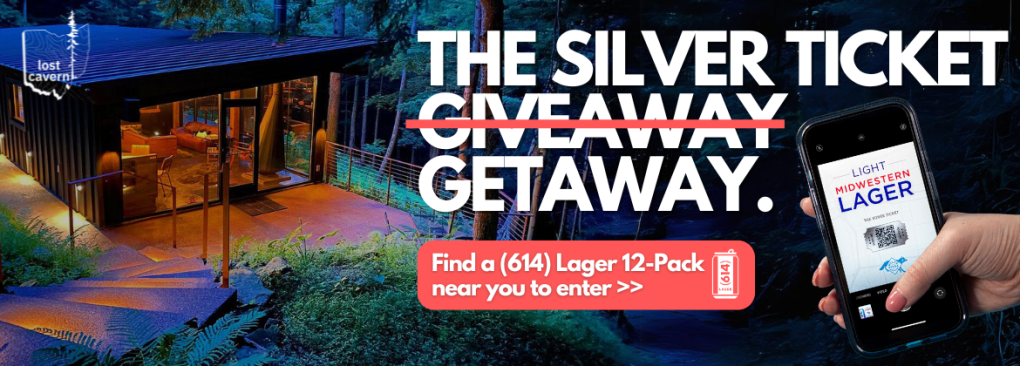Uncovering Columbus: Andy Grizzell
Downtown—any downtown—isn’t known for its flavor. Government and finance employees and the occasional resident mix and match in a steady stream of daily hustle and bustle—which makes the space feel much more like a campus than a neighborhood.
That’s why for years nothing—and no one—seemed to fill the space once the street lights came on.
Today, perhaps feeding off the booster rocket of development that is the Short North, downtown is getting more character by the month—but to photographer Andy Grizzell, it’s always been there. You just have to know where to look.
He’s found his niche one f stop away from voyeur—becoming the people’s people watcher, fascinated with what can be found under a clutched umbrella, through a shop window, or tucked into a doorway.
The result is an all new view of the city—one that feels at once vibrant and vintage, a diverse cross-section of the city’s core, by age, race, and style.
I always feel Columbus is relatively boring from an architecture standpoint, so does that engender a larger focus on the people?
For sure! I tried architecture and urban landscape shots for a while and wasn’t really feeling it. Camping out for a sunrise over the Columbus skyline didn’t deliver the same rush as a simple candid street shot did. I also shoot with a narrow focal length, so there’s more focus on the subject and separation from the background in my images. I do have plans to incorporate more of downtown into my shots to really add that element of location into my work.
Windows: I don’t know if I’ve ever seen a better use of them as a literal framing device. Is it that you can create an intimate feel with the viewer?
Ah… Framing! If I could frame and even subframe my subject in every shot I would. Windows make it so easy to accomplish that. There are many other elements of composition and fine art I try to incorporate into my street photography. I take a good mix of moments as well as photos with a strong compositional element that are geared more towards prints and fine art. In regard to the windows, there is an anticipated and socially acceptable people-watching element that comes with sitting on the inside. It’s much more awkward raising my camera and capturing what goes on from the outside. What’s odd is that I get nervous every single time I shoot into a window and I’ve never been met with a negative response. I get that the subject is more or less trapped on the other side of the widow, but I am usually met with a wave, a smile, a look away. Occasionally folks look behind them and wonder what I am taking a photo of.
There certainly is a voyeuristic quality to your work, but yet all these subjects still feel connected to you, and by extension, to us. How do you pull that off?
Well for one, it took me a long time to get comfortable taking pictures of people. When I first started doing street photography I took a lot of pictures of people’s backs. I also shot from the hip and hoped for something good. Last summer I made a goal that I would work on boldness and not care about anything else. A little bit of practice goes a long way. I also realized after the first few times of aiming my lens directly at someone it’s significantly less awkward than expected. Now I try to capture the moment and if that means there is potential for confrontation then so be it. I am also sharing a small percentage of the photos I take. I usually delete 90 percent or more of the photos I make. Eye contact helps with that connection aspect. Photos without it don’t have the same feeling. At times, I have to wait for quite a while for someone to look at me so I can snap their photo and be on my way.
Do you ever wish to know more about your subjects—what conversation spurred that quick kiss, or what thoughtful expression, or is that mystery part of the fun?
The mystery is definitely part of the fun for me! I often have ideas about people and why they are dressed a certain way. I like to think most people I photograph probably work at some swanky downtown ad agency and could play a role on Mad Men. Learning the reality of their situation may kill the rush I got from photographing someone important. For example, the man smoking in the doorway; I see him regularly and he is usually impeccably dressed. I could stop and have a conversation with him, but I’m sure that would change my perspective of him. With that being said I do enjoy when people recognize themselves or a friend and let me know on Instagram.
One of the first things that drew me to your work is how interesting you make Downtown look, when on an average day, it can just seem like people moving along. Is that a big part of what makes you stop and snap? This dichotomy of people who live there and people just coming and going?
Yeah, I definitely like to capture moments that are otherwise taken for granted. Something as small as a hand opening a door, or an umbrella being opened, or a couple resting cheek to cheek in a bar. Our downtown is not enormous, but it’s fun during the evening rush to slow down and just look for moments and details. I would like to do some more of the true social photography and really capture the obvious dichotomy between the haves and the have-nots. There are rich and poor, homeowners and homeless, CEOs and the jobless rubbing shoulders all day. I love it!
BROUGHT TO YOU BY




